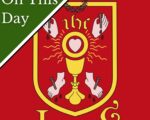
On this day in Tudor history, 7th April, Charles VIII of France died after hitting his head on a lintel; Robert Aske and Thomas Darcy, 1st Baron Darcy, were sent to the Tower of London for their parts in the Pilgrimage of Grace rebellion; and Elizabeth Boleyn, Countess of Wiltshire, was buried…
[Read More...]







